Apple G4 17-inch User Manual

PowerBook G4 17 inch
Getting Started
Includes setup, expansion, and troubleshooting information for your PowerBook G4 computer
K Apple Computer, Inc.
© 2003 Apple Computer, Inc. All rights reserved.
Under the copyright laws, this manual may not be copied, in whole or in part, without the written consent of Apple.
The Apple logo is a trademark of Apple Computer, Inc., registered in the U.S. and other countries. Use of the “keyboard” Apple logo (Option-Shift-K) for commercial purposes without the prior written consent of Apple may constitute trademark infringement and unfair competition in violation of federal and state laws.
Every effort has been made to ensure that the information in this manual is accurate. Apple is not responsible for printing or clerical errors.
Apple
1 Infinite Loop Cupertino, CA 95014-2084 408-996-1010 www.apple.com
Apple, the Apple logo, AirPort, Apple Store, AppleTalk, FireWire, the FireWire logo, iTunes, Mac, the Mac logo, Macintosh, PowerBook, QuickTime, and Sherlock are trademarks of Apple Computer, Inc., registered in the U.S. and other countries.
Finder, iDVD, iMovie, iPhoto, iPod, and SuperDrive are trademarks of Apple Computer, Inc.
ENERGY STAR® is a U.S. registered trademark.
Java is a trademark of Sun Microsystems, Inc.
PowerPC is a trademark of International Business Machines Corporation, used under license therefrom.
Other company and product names mentioned herein are trademarks of their respective companies. Mention of third-party products is for informational purposes only and constitutes neither an endorsement nor a recommendation. Apple assumes no responsibility with regard to the performance or use of these products.
The product described in this manual incorporates copyright protection technology that is protected by method claims of certain U.S. patents and other intellectual property rights owned by Macrovision Corporation and other rights owners. Use of this copyright protection technology must be authorized by Macrovision Corporation and is intended for home and other limited viewing uses only unless otherwise authorized by Macrovision Corporation. Reverse engineering or disassembly is prohibited.
Apparatus Claims of U.S. Patent Nos. 4,631,603, 4,577,216, 4,819,098 and 4,907,093 licensed for limited viewing uses only.
Simultaneously published in the United States and Canada.
Sherlock’s Yellow Pages channel may be known by a different term outside the United States.

Contents
1 Getting Started |
7 |
|
|
|
|
|
Plugging In the Computer |
8 |
|
|
|
|
|
Calibrating Your Battery for Best Performance |
9 |
|||||
Connecting the Internal Modem |
9 |
|
|
|||
Opening the Display |
10 |
|
|
|
|
|
Turning the Computer On |
11 |
|
|
|
||
Moving Items on the Screen |
12 |
|
|
|
||
Adjusting the Internal Display |
14 |
|
|
|
||
Where to Go From Here |
16 |
|
|
|
|
|
What to Do When You Are Finished Working |
17 |
|||||
2 Getting to Know Your Computer |
19 |
|||||
Basic Features of Your PowerBook |
20 |
|
|
|||
Additional Features of Your PowerBook |
22 |
|
||||
Inside Your PowerBook |
|
24 |
|
|
|
|
About Mac OS X 26 |
|
|
|
|
|
|
.Mac—Internet Services for Mac Users 27 |
|
|||||
Sherlock—Your Internet Search Detective |
28 |
|||||
Apple.com—Your Starting Place on the World Wide Web 29 |
||||||
QuickTime—Audio and Video on the Internet |
30 |
|||||
iMovie—Create and Edit Your Own Digital Movies 31 |
||||||
iPhoto—Organize, Edit, and Share Your Digital Photographs 32 |
||||||
iDVD—Create and Burn Your Own DVDs |
33 |
|
||||
iTunes—Digital Music for Your Mac and iPod |
34 |
|||||
Auto Updating—Automatically Keep Your Mac on the Cutting Edge 35
3
|
iChat—Chat With Friends Over the Internet |
36 |
|
|
||||||
|
iCal—Organize and Share Your Calendars |
37 |
|
|
||||||
|
User Accounts—Turn One Mac Into Many |
38 |
|
|
||||||
|
Mac Help—Answers to All Your Macintosh Questions |
39 |
|
|||||||
3 |
Using Your Computer |
41 |
|
|
|
|
||||
|
Universal Serial Bus (USB) |
42 |
|
|
|
|
|
|||
|
FireWire |
44 |
|
|
|
|
|
|
|
|
|
PC Cards |
46 |
|
|
|
|
|
|
|
|
|
Using Bluetooth Devices |
47 |
|
|
|
|
|
|||
|
AirPort Wireless Internet and Networking |
48 |
|
|
||||||
|
Ethernet (10/100/1000Base-T) |
49 |
|
|
|
|
||||
|
External Video Support (DVI/VGA, Composite, and S-Video) |
50 |
||||||||
|
Battery |
53 |
|
|
|
|
|
|
|
|
|
Using Your SuperDrive |
56 |
|
|
|
|
|
|
||
|
Recording Information on a DVD |
59 |
|
|
|
|
||||
|
Keyboard Controls |
60 |
|
|
|
|
|
|
|
|
|
Security Slot 62 |
|
|
|
|
|
|
|
|
|
4 Working With Your Operating System |
63 |
|
||||||||
|
About Mac OS X |
63 |
|
|
|
|
|
|
|
|
|
Using Classic in Mac OS X 64 |
|
|
|
|
|
||||
5 |
Adding Memory to Your Computer 65 |
|
|
|||||||
|
Installing Additional Memory |
65 |
|
|
|
|
||||
|
Making Sure Your Computer Recognizes the New Memory |
70 |
||||||||
6 |
Troubleshooting |
71 |
|
|
|
|
|
|
||
|
Information in This Chapter |
71 |
|
|
|
|
||||
|
Problems That Prevent You From Using Your Computer 72 |
|
||||||||
|
Restoring Your Computer’s Software |
73 |
|
|
|
|||||
|
Other Problems |
74 |
|
|
|
|
|
|
|
|
|
Using Apple Hardware Test |
75 |
|
|
|
|
|
|||
|
Locating Your Product Serial Number |
75 |
|
|
|
|||||
4Contents
Appendix A
Specifications 77
Apple System Profiler 77
PowerBook Specifications 78
Appendix B
Care, Use, and Safety Information 81
Cleaning Your PowerBook |
81 |
Carrying Your PowerBook |
81 |
Storing Your PowerBook |
81 |
Safety Instructions for Setting Up and Using Your Computer 82
General Safety Instructions |
83 |
Apple and the Environment |
84 |
Ergonomics 84 |
|
Appendix C
Connecting to the Internet 87
Dialup (PPP) Connections 88
DSL, Cable Modem, or LAN Internet Connections 91 Troubleshooting Your Connection 96
Contents 5
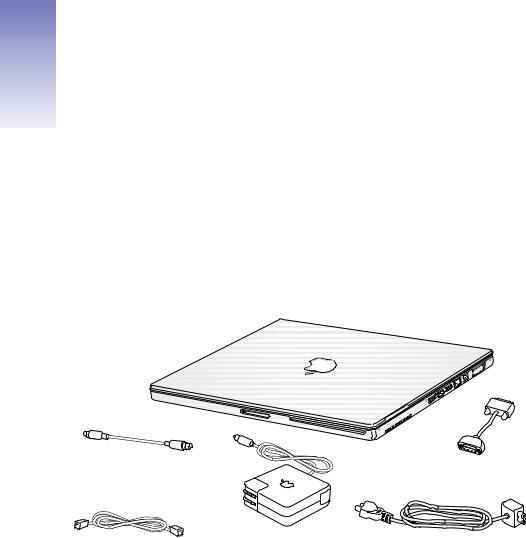
C H A P T E R
1
Getting Started
Your PowerBook has been designed so that you can set it up quickly and start using it right away. If you have never used a PowerBook or are new to Macintosh computers, read this section for instructions on getting started and where to get more information.
If you are an experienced user, you may already know enough to get started. Be sure to look over the information in Chapter 2, “Getting to Know Your Computer,” to find out about the new features of this PowerBook.
Apple VGA
Æ
Apple Video
adapter
S-video-to-composite adapter |
|
DVI-to-VGA adapter |
|
|
|
AC plug |
|
|
Phone cord |
Power adapter |
AC cord |
Important Read all the installation instructions and safety information (see page 81) carefully before you plug your computer into a wall socket.
7
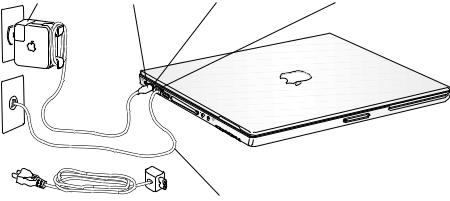
Plugging In the Computer
Plugging in the power adapter provides AC power to the computer and recharges the computer’s battery. You should plug in the power adapter in case the battery has been drained during shipping or storage.
Important If you use a power adapter other than the one that came with your computer, make sure it is a 65-watt (W) Apple Portable Power Adapter.
1Insert the AC plug on the power adapter into a wall outlet. If you want to extend the reach of your power adapter, remove the AC plug from the adapter and attach one end of the included AC cord to the adapter. Plug the other end into a wall outlet. Use only the AC cord that came with your power adapter.
AC plug |
Power adapter plug |
¯ Power adapter port |
W Internal modem |
AC cord |
Telephone cord |
2Plug the power adapter plug into the power adapter port (marked with the icon ¯) on the left side of the computer. Make sure to push the power plug snugly into the power adapter port to ensure it is engaged and power is flowing to the computer.
When the power adapter is connected properly, a light appears on the plug. An amber light indicates that the battery is being charged. A green light indicates that the battery is fully charged. You can monitor the battery level using the battery icon in the menu bar, or by checking the charge lights on the bottom of the battery (see page 53).
You can wrap any excess adapter cable around the clips on the power adapter. When disconnecting the power adapter from an outlet, pull the plug, not the cord.
8 Chapter 1

Calibrating Your Battery for Best Performance
To get the longest running time from your PowerBook battery, let the battery run down completely during the first week you have your PowerBook. Then fully charge it one time. Follow these steps:
1Plug in the power adapter and fully charge your PowerBook battery until the battery indicator lights and the onscreen meter indicate that the battery is fully charged. A green light on the power adapter plug also indicates that the battery is fully charged.
2Disconnect the power adapter and use your PowerBook. When your battery gets low, you will see the first low battery warning dialog on the screen. Continue to use your PowerBook until it goes to sleep; at that point the battery has been sufficiently drained for calibration.
3Connect the power adapter and leave it connected until the battery is fully charged again.
Important You have to fully discharge and then charge your battery only once to calibrate it. After that, you can connect and disconnect the power adapter when the battery is at any charge level.
Connecting the Internal Modem
If you want to connect to the Internet right away, connect one end of the included phone cord to the modem port (marked with the icon W) on the left side of the computer, and the other end to an analog telephone line (the type of telephone line found in most residences). When you turn on your PowerBook for the first time, a Setup Assistant walks you through the rest of the steps necessary for connecting to the Internet. For more detailed information, see Appendix C, “Connecting to the Internet.”
Warning Do not connect a digital telephone line to the modem, because the wrong type of line could damage the modem. Contact your telephone service provider if you are unsure whether you have a digital telephone line.
Getting Started |
9 |
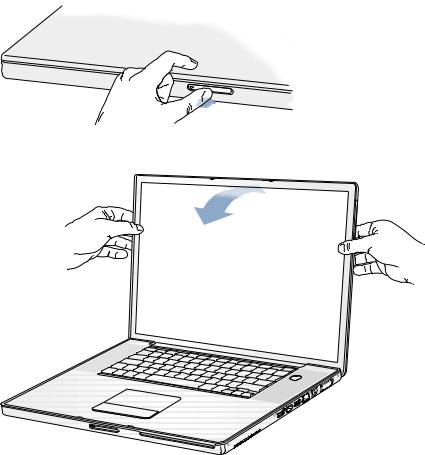
Opening the Display
1Push the display release button.
2Open the display and position it at a comfortable viewing angle.
®
Note: Your display is designed to open 130 degrees. If you meet resistance, do not attempt to force the display open farther.
10 Chapter 1
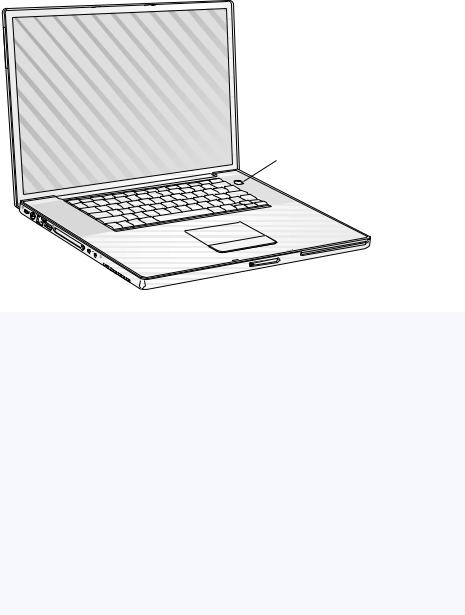
Turning the Computer On
To turn on the computer, press the Power button (®). You should hear a tone when you turn on the computer. It takes the computer a few moments to start up. This is normal. When you press the Power button, the PowerBook checks its memory before it starts up. The more memory installed, the longer the delay.
® Power button
®
Problems Turning the Computer On?
Nothing happens when you press the Power button.
mMake sure the battery is properly installed. Push the silver button on the battery to check its charge. See “Battery” on page 53.
mThe battery may be drained. Make sure that you plugged the power adapter firmly into both the computer and a power source.
mIf the computer still doesn’t start up, see page 73 for more troubleshooting suggestions.
mIf you are using a power adapter other than the one that came with your computer, make sure it is a 65 W Apple Portable Power Adapter.
You see a picture of a disk or a folder with a blinking question mark.
mThis icon usually means that the computer can’t find system software on the hard disk or any disks connected to the computer. You may need to reinstall system software. See page 73.
Getting Started 11
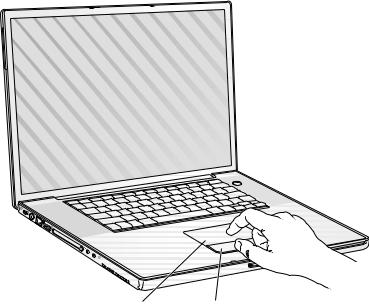
Moving Items on the Screen
You use your PowerBook trackpad to move and select items on the screen, much as you use a mouse with a desktop computer. To move the arrow pointer on the screen, slide your finger across the trackpad. To select, click, or double-click an item on the screen, use the trackpad button.
Note: Instead of using the trackpad button, you can select, click, and double-click directly on the trackpad. You turn on this and other trackpad options in the Mouse pane of System Preferences.
®
Trackpad |
Trackpad button |
The trackpad is sensitive to how quickly you move your finger. To move the pointer a short distance across the screen, move your finger slowly across the trackpad. The faster you move your finger, the farther the pointer moves on the screen.
12 Chapter 1

Tips for Using the Trackpad
For best results when using the trackpad, keep in mind these tips:
mUse only one finger.
mDo not use a pen or any other object.
mKeep your finger and the trackpad dry. If the trackpad becomes moist from humidity or condensation, gently wipe it with a clean cloth before you use it.
mNever use any kind of cleaning solution on the trackpad.
mIf you are using the trackpad and the keyboard at the same time, and the trackpad is not responding accurately, the computer may be set to ignore the trackpad while you are typing. You can change this setting in the Mouse pane of System Preferences.
For more information on using the trackpad, see Mac Help, located in the Help menu.
Getting Started 13
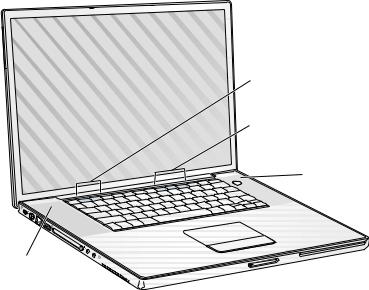
Adjusting the Internal Display
Once you begin working with your new PowerBook, you may need to adjust your display so that items on the screen are easier to see.
Adjusting the Display Brightness and Keyboard Illumination
Your PowerBook is equipped with an ambient light-sensing (ALS) system. Sensors under the speaker grilles automatically adjust the brightness of your display and keyboard illumination according to the light available in your current environment. You can also adjust the automatic brightness settings of your display and keyboard manually, using the brightness control keys and the keyboard illumination control keys.
To turn off the automatic display brightness feature, open the Displays pane of System Preferences and deselect the automatic brightness checkbox. You can turn off the keyboard illumination feature in the Keyboard pane of System Preferences or by pressing the F8 key.
Note: Even when the keyboard illumination feature is on, the keyboard illuminates only in low-light situations.
¤ Brightness controls

 Keyboard illumination controls
Keyboard illumination controls
ALS sensor
®
ALS sensor
14 Chapter 1
Resolutions Supported by the Built-in Display
Your PowerBook has a wide-screen display that has a standard (sometimes called “native”) resolution of 1440 x 900 and that supports standard resolutions such as 1024 x 768.
You may want to use a standard resolution when mirroring your display on an external monitor or when using certain applications (such as games or presentation software) that are designed for a standard resolution. Most applications automatically switch to the best resolution for them.
When you use a standard resolution, a black band appears on each side of the display. If you use an application designed for a standard resolution and do not want to see the black bands, you can choose the “stretched” version of the resolution to stretch the image to cover the entire screen and eliminate the black bands.
You can choose a resolution of 1152 x 768 or smaller from the Displays pane in System Preferences. These are known as “scaled resolutions.” When you switch to a scaled resolution, items on the screen appear larger, making them easier to see.
Note: Scaled resolutions may not be as sharp as the display’s native resolution.
Adjusting the Display Resolution
You can increase the size of images on your display by switching from the standard resolution to a scaled resolution.To adjust the resolutions on your display, open the Displays pane of System Preferences. To quickly access your display settings from the menu bar, click “Show displays in menu bar.”
Getting Started 15
Where to Go From Here
You’ve done everything you need to get your PowerBook up and running. The first time you turn your computer on, the Macintosh Setup Assistant takes you through the process of configuring your computer and setting up for the Internet. Internet access usually requires an account with an Internet service provider (ISP). Fees may apply.
If you would like additional information, see the following:
To learn about... |
See... |
|
|
Shutting down your computer or putting |
“What to Do When You Are Finished Working” on |
it to sleep |
page 17. |
|
|
What you can do with the hardware and |
Chapter 2, “Getting to Know Your Computer.” |
software features of your PowerBook |
|
|
|
The additional information available in the |
“Mac Help—Answers to All Your Macintosh |
onscreen help |
Questions” on page 39. |
|
|
Using a specific feature of your PowerBook |
Chapter 3, “Using Your Computer.” |
|
|
Installing memory |
Chapter 5, “Adding Memory to Your Computer.” |
|
|
What to do if you have a problem with your |
Chapter 6, “Troubleshooting.” |
PowerBook |
|
|
|
16 Chapter 1

What to Do When You Are Finished Working
When you have finished working with your PowerBook, you have two options.
Put Your PowerBook to Sleep
If you will be away from your PowerBook for only a short time, put the computer to sleep. When the computer is in sleep, you can quickly wake it and bypass the startup process. When the computer is in sleep, its screen is dark and a small white light on the display release button pulsates.
To put the computer to sleep, do one of the following:
mClose the display.
mPress and release the Power button and then click Sleep.
mChoose Apple (K) > Sleep (click the Apple menu and choose Sleep).
Warning Wait a few seconds until the sleep light starts pulsating (indicating that the computer is in sleep and the hard disk has stopped spinning) before you move your PowerBook. Moving your computer while the hard disk is spinning can damage the hard disk, causing loss of data or the inability to start up from the hard disk.
To wake the computer:
mIf the display is closed, open it. Your PowerBook wakes from sleep when you open the display.
mIf the display is already open, press the Power button (®) or any key on the keyboard.
Shut Down Your PowerBook
If you will not use your PowerBook for a day or two, shut it down. Do one of the following:
mChoose Apple (K) > Shut Down.
mPress the Power button and click Shut Down in the dialog that appears on the screen.
mIf you plan to store your PowerBook for an extended period of time, see “Storing Your PowerBook” on page 81 for additional steps to prevent your battery from draining completely.
Getting Started 17

C H A P T E R
2
Getting to Know Your Computer
If you’re eager to get started and want to try out a few things on your PowerBook, this chapter is for you. It provides an overview of your computer’s hardware and software features along with the unique Internet services available to Mac owners.
Your PowerBook is a full-featured notebook computer. It includes the latest in computer technology such as a PowerPC G4 processor, FireWire and USB ports, Bluetooth wireless connectivity, and integrated AirPort wireless Internet and networking. Your computer also comes with the Mac OS X operating system, whose features enable you to use the Internet to watch video, research information, shop, and update your software automatically.
Your PowerBook comes with several software applications for doing things like sending email, surfing the Internet, chatting online, organizing music and digital photos, making movies, and much more. This chapter describes these applications and tells you where to find more information about using them. Read on to learn more.
Note: Because Apple frequently releases new versions and updates to its system software, applications, and Internet site, images shown in this manual may be slightly different from what you see on your screen.
19
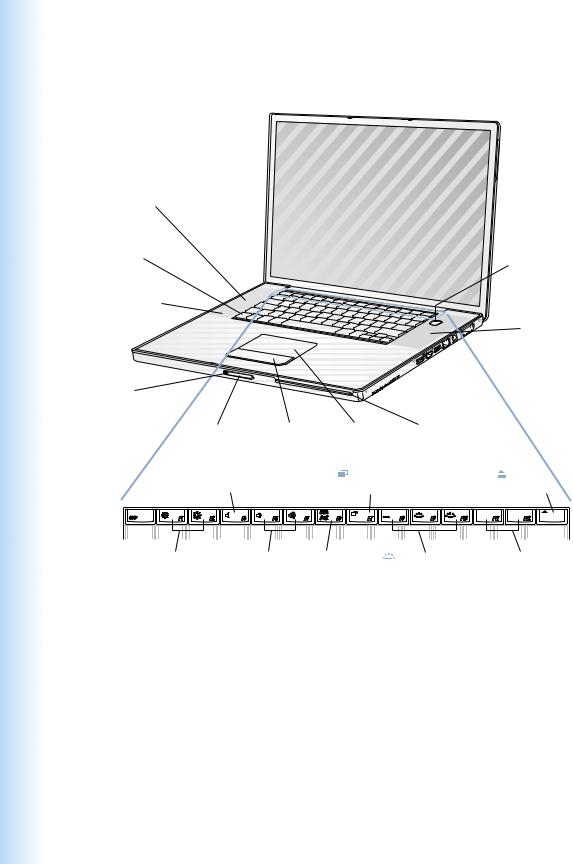
Basic Features of Your PowerBook
Built-in speaker
Function key (Fn)
Microphone
®
Sleep indicator light
Display |
Trackpad |
Trackpad |
Slot-loading |
release button |
button |
|
optical drive |
 AirPort antenna window
AirPort antenna window
®Power button
Built-in speaker
— Mute |
|
Video Mode |
Media |
||
|
|||||
|
|||||
control |
|
Toggle key |
Eject key |
||
|
|
|
|
|
|
|
|
|
|
|
|
|
|
|
|
|
|
¤ Brightness |
- Volume |
Num Lock |
Keyboard illumination |
Standard |
controls |
controls |
key |
controls |
function keys |
20 Chapter 2

¤
-
Brightness controls
Increase or decrease the brightness of your PowerBook display.
Volume controls
Increase or decrease the volume of the sound coming from the built-in speakers and sound output port.
Keyboard illumination controls
Increase or decrease the brightness of your keyboard illumination.
Num Lock key
Activate the numeric keypad embedded in the PowerBook keyboard. When the numeric keypad is locked, a green light glows on the keyboard lock key.
Video Mode Toggle key
Use this key to switch between dual display mode and video mirroring mode.
Media Eject key
Press and hold this key to eject a CD or DVD disc. You can also eject a disc by dragging its desktop icon to the Trash.
Microphone
Record sounds directly on your PowerBook hard disk with this built-in microphone (located under the left speaker cover).
Built-in speakers (2)
Listen to music, movies, games, and multimedia.
Function (Fn) key
Press and hold this key to activate the function keys (F1 to F12).
Sleep light indicator
A white light pulsates when the PowerBook is in sleep.
Display release button
Push this button to release your display and open your PowerBook.
Trackpad
Move the pointer on the PowerBook display.
Slot-loading SuperDrive
Your SuperDrive can read CD-ROM discs, Photo CDs, standard audio discs, DVD-ROM and DVD-R discs, DVD movies, and other kinds of media. It can also write music, documents, and other digital files on CD-R, CD-RW, and DVD-R discs.
®Power button
Turn your PowerBook on and off or put it to sleep.
AirPort antenna window
With an optional AirPort Base Station, or other wireless hub, connect to the Internet wirelessly.
Getting to Know Your Computer |
21 |

Additional Features of Your PowerBook
®
¯ Power |
|
adapter port |
USB port PC Card slot |
Security |
W Internal |
Audio line in |
f Headphone |
slot |
modem port |
port |
port |
®
|
FireWire 800 port |
Æ TV out port |
|
|
USB port |
FireWire |
G Gigabit Ethernet port |
DVI |
|
|
400 port |
(10/100/1000Base-T) |
port |
|
22 Chapter 2

¯
W
Security slot
Protect your PowerBook by connecting a security cable.
Power adapter port
Plug in the included Apple Portable Power Adapter to recharge your PowerBook battery.
Internal modem port
Connect a standard phone line directly to the internal modem.
Two USB (Universal Serial Bus) ports
Connect additional equipment to your PowerBook, such as printers, external storage devices, digital cameras, modems, keyboards, and joysticks.
f
G
Æ
PC Card slot
Expand the capabilities of your PowerBook using the Type II slot that supports both PC Card and CardBus formats.
Audio line in port
Connect your PowerBook to a line-level microphone or other audio equipment.
Headphone port
Connect external speakers, headphones, or other sound output devices.
Two FireWire ports
Connect high-speed external devices, such as digital video cameras, printers, and external storage devices. You can connect a standard 6-pin FireWire device directly to the FireWire 400 port, or you can use a 9-to-6-pin FireWire cable to connect the device to the FireWire 800 port. You can also directly connect a 9-pin FireWire device to the FireWire 800 port. For more information, see page 44.
Ethernet port (10/100/1000Base-T)
Connect to a high-speed 10/100/1000Base-T Ethernet network or connect to another computer and transfer files. The Ethernet port auto-sensing feature detects other Ethernet devices. You don’t need an Ethernet crossover cable to connect to other Ethernet devices.
TV out (S-video out) port
Connect your PowerBook to a television, VCR, or other video device. You can use the TV out port for presentations or to play a DVD-Video on your television.
External monitor (DVI) port
Connect to an external monitor or projection device that uses a DVI connector, or use the included DVI-to-VGA adapter to connect a VGA monitor. You can also use a DVI-to-ADC adapter (sold separately) to connect to an Apple flat-panel display.
Getting to Know Your Computer |
23 |
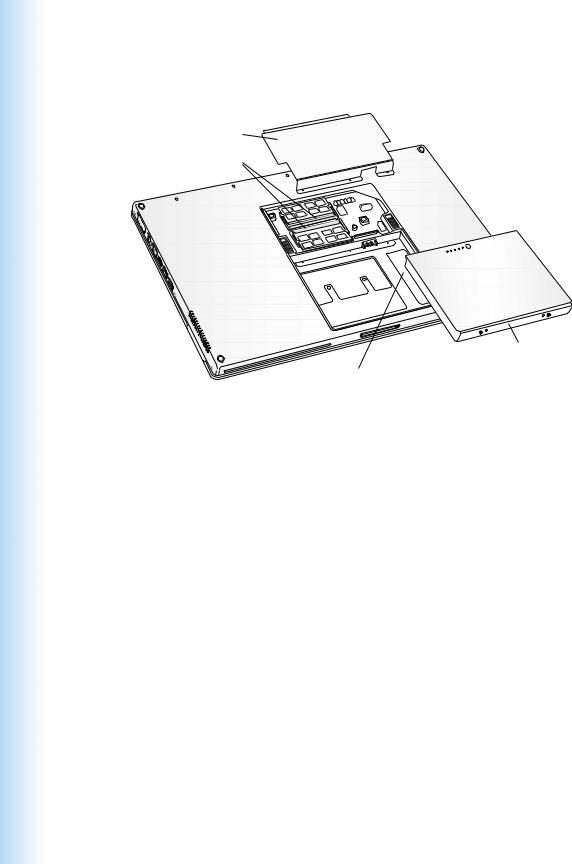
Inside Your PowerBook
Memory cover
24 Chapter 2

Memory slots
Your PowerBook comes with two memory slots, one above the other. The lower slot contains the memory module that came with your PowerBook. You can install an additional memory module in the upper slot. (If you ordered your PowerBook with additional memory, the upper slot may already be filled.) The maximum amount of RAM you can install in your PowerBook is 1 gigabyte (GB), using a 512 megabyte (MB) memory module in each slot. For instructions, see “Installing Additional Memory” on page 65.
Battery
Your PowerBook comes with a battery that provides power when the external power adapter is not connected. For more information, see page 53.
Getting to Know Your Computer |
25 |
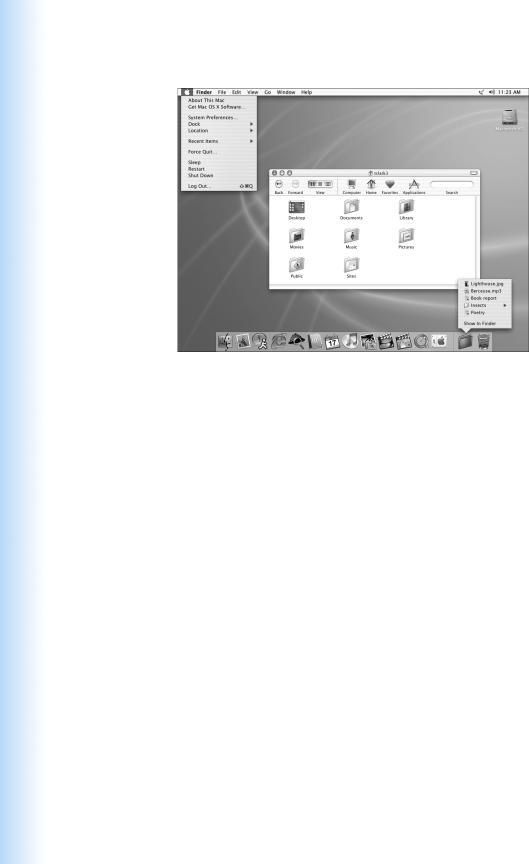
About Mac OS X
What You Can Do
Mac OS X provides a powerful and elegant user interface for your computer. With Mac OS X, you don’t need to worry about how much memory to allot for an application to run efficiently or restarting your computer if there’s a problem with one application. In addition to using Mac OS X software, you can still run Mac OS 9 versions of software in Mac OS X using the Classic environment. Chapter 4, “Working With Your Operating System,” on
page 63 explains the Classic environment in more detail. Mac OS X also supports Java and UNIX-based software.
System Preferences is your command center for all of your computer settings, from changing the appearance of your desktop to setting up network access information. The Finder and Dock provide easy access to folders, applications, documents, and other items on your computer and network.
To Learn More
mFor instructions on how to customize your Mac OS X environment and information about using Mac OS X, see Welcome to Mac OS X, a document on your computer’s hard disk (in Documents/Learn More About Your Mac).
mFor the latest information on Mac OS X, go to the Mac OS website at www.apple.com/macos.
26 Chapter 2
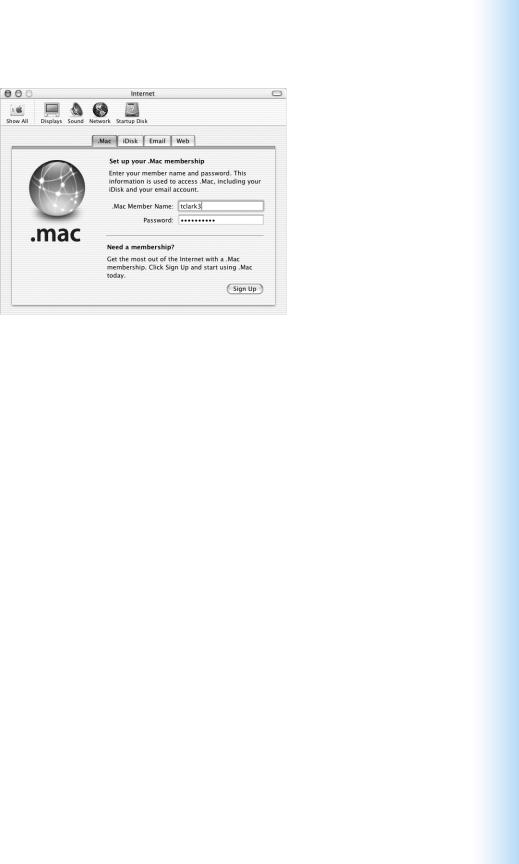
.Mac—Internet Services for Mac Users
What You Can Do
.Mac is a new class of Internet services from Apple created exclusively for Mac users. With a
.Mac account, you can send email or electronic greeting cards and share photos and movies. You can back up important files, create your own website, and more. To use .Mac, you must have an account with an Internet Service Provider (ISP).
To Learn More
m Go to www.mac.com.
To Sign Up
m Open System Preferences and click Internet. Click .Mac and then click Sign Up.
Getting to Know Your Computer |
27 |

Sherlock—Your Internet Search Detective
What You Can Do
Sherlock is your search detective and personal shopper on the Internet. It provides an easy way to find people, news, and just about anything. Shop for books and music, search auction sites, find the best prices—even check product availability. Look up movie times at your local theaters, watch movie trailers, and buy tickets. Find flight information, stock quotes, phone numbers, and driving directions. Get definitions, news, language translations, and more.
To Learn More
mOpen Sherlock and choose Help > Sherlock Help.
mGo to www.apple.com/sherlock.
Note: Sherlock’s Yellow Pages channel may be known by a different term outside the United States.
28 Chapter 2

Apple.com—Your Starting Place on the World Wide Web
What You Can Do
Whether you’re looking for information about Apple products or for services, support, and technical information, Apple websites help you get the most from your computer.
To Learn More
Visit the following websites for more information:
mApple Store: www.store.apple.com
mApple Support: www.apple.com/support
mMacintosh Products Guide: www.apple.com/guide
mMac OS X: www.apple.com/macosx
Getting to Know Your Computer |
29 |
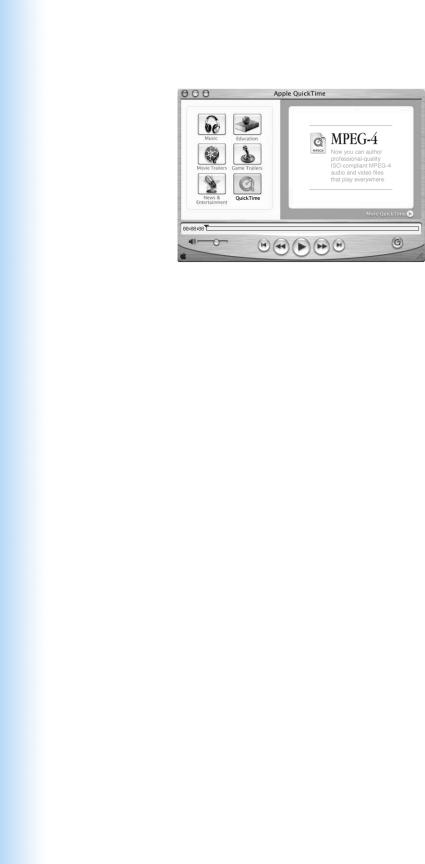
QuickTime—Audio and Video on the Internet
What You Can Do
In addition to playing video and music files on your Mac, with QuickTime you can watch live and recorded Internet broadcasts.
To Get Started
1Connect to the Internet.
2Open QuickTime Player.
3Click the QuickTime button and select a channel to get the latest video, music, and information over the Internet without having to store files on your hard disk.
To Learn More
Internet video is just one of the things you can do with QuickTime. To learn more:
mOpen QuickTime and choose Help > QuickTime Help.
mGo to www.apple.com/quicktime.
30 Chapter 2
